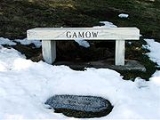
George Gamow
George Gamow [pronounced "GAM-off"] (1904-03-04 – 1968-08-19) was a Ukrainian born physicist and cosmologist. He developed the Big Bang theory of cosmology, using it to predict the existence of Cosmic background radiation, and his insight that DNA nucleotides probably formed a "a triplet code of four symbols" was influential on very important research and discoveries in genetics. His birth name was Георгий Антонович Гамов (Georgiy, [or Gyorgy] Antonovich Gamov).
Sourced
- It was a bank holiday, and Mr Tompkins, the little clerk of a big city bank, slept late and had a leisurely breakfast. Trying to plan his day, he first thought about going to some afternoon movie and, opening the morning paper, turned to the entertainment page. But none of the films looked attractive to him. He detested all this Hollywood stuff, with infinite romances between popular stars.
If only there were at least one film with some real adventure, something unusual and maybe even fantastic about it. But there was none. Unexpectedly, his eye fell on a little notice in the corner of the page. The local university was announcing a series of lectures on the problems of modern physics, and this afternoon's lecture was to be about Einstein's Theory of Relativity. Well, that might be something!- Mr. Tompkins in Wonderland. (1939) First lines
- There was a young fellow from Trinity,
Who took the square root of infinity.
But the number of digits, Gave him the fidgets;
He dropped Math and took up Divinity.- One, Two, Three... Infinity (1947)
- I decided to get Ph.D. in experimental physics because experimental physicists have their own room in the Institute where they can hang their coat, whereas theoretical physicists have to hang their coat at the entrance.
- Interview with George Gamow, by Charles Weiner at Professor Gamow's home in Boulder, Colorado, April 25, 1968http://www.aip.org/history/ohilist/4325.html.
- I feel that matter has properties which physics tells you.
- Interview with George Gamow, by Charles Weiner at Professor Gamow's home in Boulder, Colorado, April 25, 1968http://www.aip.org/history/ohilist/4325.html.
About George Gamow
- If contribution in life is measured by the influence of a person's best ideas, then George Gamow's contribution has been immense. He explained radioactive decay, described reaction mechanisms and rates in the interior of stars, proposed how the elements were made, and suggested how DNA might provide the code for protein synthesis. Those topics have evolved into major fields of science...
- Professor William C. Parke, George Washington University, in GW Magazine (Spring, 2000)
- Gamow was fantastic in his ideas. He was right, he was wrong. More often wrong than right. Always interesting; ... and when his idea was not wrong it was not only right, it was new.
- Edward Teller
- Take a look at George Gamow, who is now recognized as one of the great cosmologists of the last hundred years. I speculate that he probably didn't win the Nobel Prize because people could not take him seriously. He wrote children's books. His colleagues have publicly stated his writing children's books on science had an adverse effect on his scientific reputation, and people could not take him seriously when he and his colleagues proposed that there should be a cosmic background radiation, which we now know to be one of the greatest discoveries of 20th-century physics.
- Michio Kaku
- The physicist George Gamow was also an entertaining popularizer. He once told the story of how with his wife and their baby daughter he visited the Leaning Tower of Pisa. As they climbed the steps, they noticed an increasingly musty smell, which they first attributed to the ancient walls of the building. Then, however, they began to sspect their little girl, and by the time they reached the top it was clear that she needed immediate attention. “And from the very place,” explained Gamow, raising his arm and his voice dramatically, “where Galileo launched his experimental objects, we also propelled…”
- Rudolf Arnheim in Ballast Quarterly Review Vol 9 No 2 (Winter 1993), p. 2.
- Es Gamow't wieder
- English translation: "It Gamows again", Wolfgang Pauli joking when new papers appeared, quoted in Oral History interview transcript with George Gamow 25 April 1968, American Institute of Physics, Niels Bohr Library and Archives
